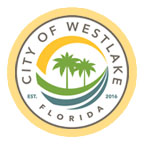The Westlake City Council gave final approval to its budget with a tax rate unchanged at 5.125 mills at a public hearing Monday, Sept. 23.
There was little public comment on the fiscal year 2019-20 budget of $4,256,700, which is 29.3 percent greater than the 2018-19 budget for the rapidly growing community.
City Manager Ken Cassel said one of the challenges for a growing city is understanding where it came from, where it’s going and how it is set up.
“In late 2013, Minto purchased about 4,000 acres of land, which included the Seminole Improvement District, which is responsible for water operations, wastewater, stormwater and other governmental powers, Cassel said. “The only thing that Seminole did not have was comprehensive planning and zoning, building and police department functions.”
At the end of 2013, Minto submitted an application to Palm Beach County for a master-planned development, and about a year later received approval for 4,554 dwelling units and 2.2 million square feet of non-residential development. Immediately after that, Minto filed for a staff-level permit to begin development.
“The vision was to set up a unique city that utilized the power of the state as well as the powers of the city to create a government light, streamlined development process minimizing bureaucratic delays,” Cassel said. “During this process, significant analysis was done to ensure that the plan was both viable and feasible and a strong emphasis to assure that the tax structure was roughly in the middle of the jurisdictions within the county.”
In April 2016, a conversion plan was submitted to the Seminole Improvement District and subsequently approved by that board, he said. “The information in that original plan was based on roughly 50 homes per year and a 5.125 millage rate,” Cassel said. “The plan also provided for a council/manager form of government and an employee-contracted city, contrary to what most municipalities are in this county.”
The election was certified, and Westlake was incorporated on June 21, 2016. “The conversion incorporation plan had a 5-year plan with 5.125 mills through 2021,” Cassel said. “The city set up an administration, city attorney, planning and zoning, building and engineering departments, and adopted the disclosed budget.”
In October 2016, the city issued its first building permit, and in January 2017, more than 500 acres were cleared. “Roads were being installed, lights were being done [and] infrastructure was being put in the ground,” Cassel continued.
By January 2018, the entire Hammocks community was platted, and houses were being built. In June 2019, the Hammocks was completely built, the Meadows was under construction and land was being cleared for the Cresswind project of 850 active senior adult units, and the 236 units of Sky Cove.
According to Cassel, accomplishments over the past year include the approval of more than 10 plats, housing, public facilities, six chapters of land development regulations, site plans for the Meadows, Sky Cove and Cresswind, a 7-Eleven store, the Palm Beach County Sheriff’s Office substation, a surgical center, an average of six single-family units per week and numerous other applications. Almost 100 homes have received certificates of occupancy.
In 2020, Cassel said he looks forward to approving at least five commercial plats.
“I anticipate at least three commercial developers coming in the next year,” he said. “We will continue to finish the remaining 13 chapters of the city’s land use development regulations over the next year. One of the items looking forward is reworking the city’s web site, including a communications process with a public relations firm. We’re going to be updating, as required, the city’s comprehensive plan.”
This will include a continued aggressive residential development schedule.
“With one developer, we were processing six a week with three homebuilders,” Cassel said. “I would expect anywhere from six to 15 a week potentially, depending on how fast they move, but right now as the market is going, they’re averaging about six applications a week coming in.”
In 2019, Westlake generated about $238,900 with the 5.125 millage rate. “Under the current evaluation of $109 million, the proposed tax revenue is about $539,600,” Cassel said. “About $1.1 million is anticipated in permitting fees, and $1.9 million in developer contributions.”
Ad valorem taxes generate about 13 percent of the total revenue, permitting is about 28 percent and 48 percent is from developer contributions.
Of the $535,600 in ad valorem revenue, about 15 percent will come from current residents, with the remaining 84 percent coming from Minto and other developers.
In 2017, Minto contributed $1.1 million; in 2018, it contributed $1 million. “This year, it’s going to be close to $1 million,” he said. “Next year, they’re scheduled to put in $1.9 million. That may change, depending on the revenue from the licenses and applications.”
The percentage of tax revenue from ad valorem taxes last year was 8 percent, and the percentage this year is 13 percent.
“One of the questions brought up last week at the meeting was confusion over the millage rate,” he said. “The millage rate is the rate per thousand dollars of taxable value used to calculate taxes. For example, if you have a property that’s worth $100,000, and it’s a one-mill rate, it’s $100 in taxes. Taxing authorities look at the amount of revenue needed to provide the services outlined in the proposed budget to meet the needs of the city, then they look at the value of the property and come up with a millage rate that would generate that revenue.”
Cassel stressed that the vast majority of taxes paid by Westlake residents go to other taxing authorities, not the city. Those include Palm Beach County, the School District of Palm Beach County, Palm Beach County Fire-Rescue, the South Florida Water Management District, the Children’s Services Council, the Health Care District and other smaller taxing entities, which amount to a total tax rate of 22.8794 mills.








